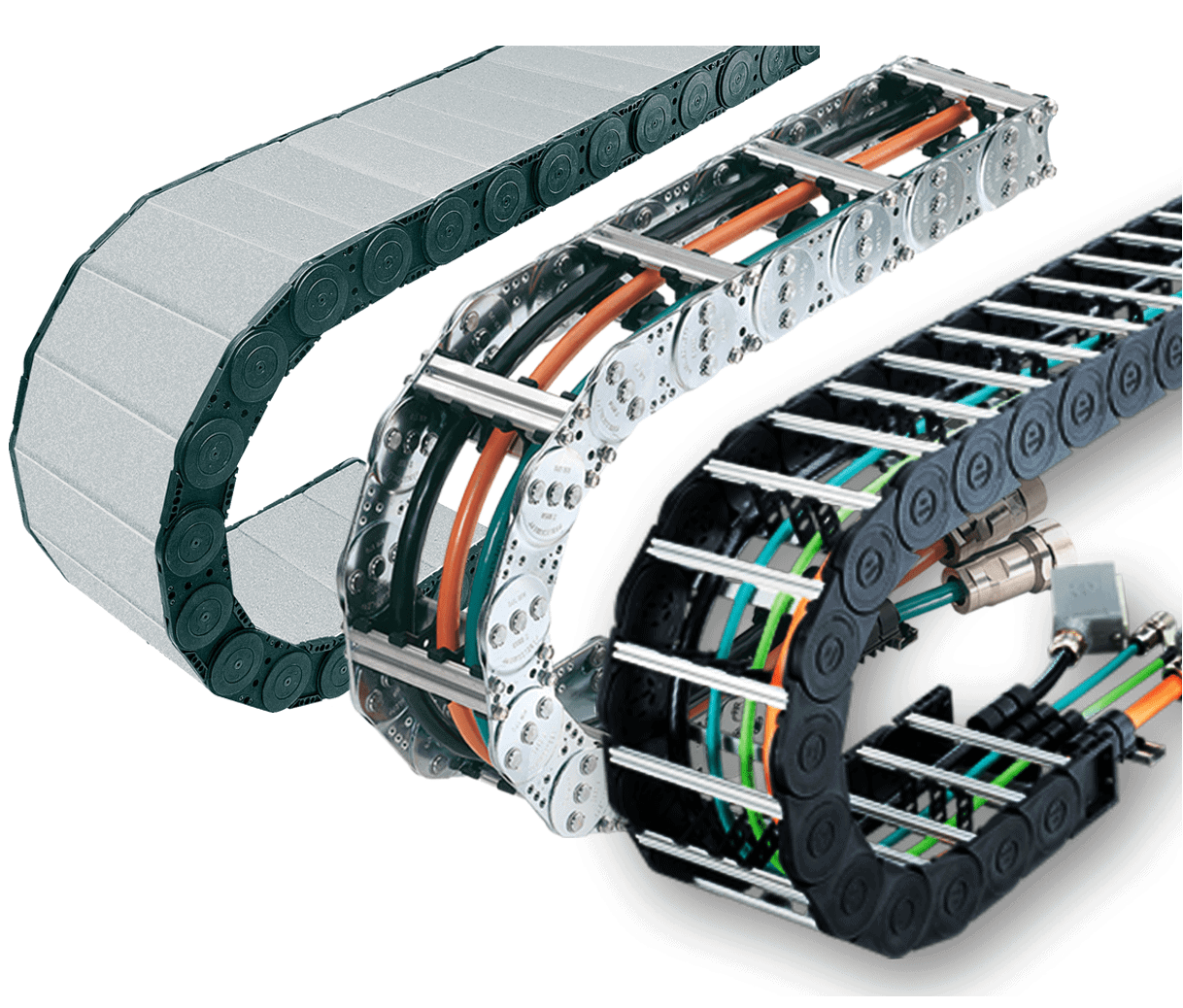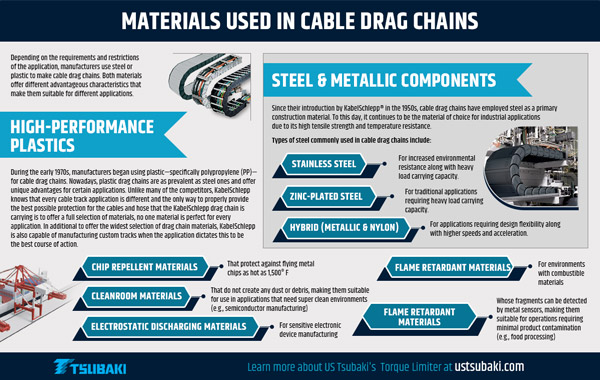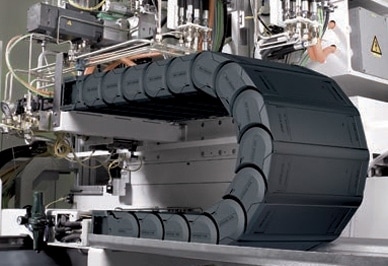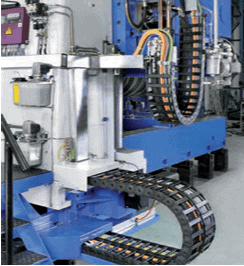All About Cable Drag Chains
Cable drag chains—also referred to as cable chains, cable carriers, cable track, and energy chains—are flexible hollow structures used to guide, support, and protect cables, hoses, and hydraulic lines when in motion. Industry professionals use them to prevent cables & hoses from tangling up or incurring damage during machine motion, both of which can cause accidents and contribute to downtime.
Materials Used in Cable Drag Chains
Depending on the requirements and restrictions of the application, manufacturers use steel or plastic to make cable drag chains. Both materials offer different advantageous characteristics that make them suitable for different applications.
Steel & Metallic Components
Since their introduction by Tsubaki-KabelSchlepp® in the 1950s, cable drag chains have employed steel as a primary construction material. To this day, it continues to be the material of choice for industrial applications due to its high tensile strength and temperature resistance.
Types of steel commonly used in cable drag chains include:
- Stainless steel for increased environmental resistance along with heavy load carrying capacity.
- Zinc-plated steel for traditional applications requiring heavy load carrying capacity.
- Hybrid (metallic & nylon) for applications requiring design flexibility along with higher speeds and acceleration.
High-Performance Plastics
During the early 1970s, manufacturers began using plastic—specifically polypropylene (PP)—for cable drag chains. Nowadays, plastic drag chains are as prevalent as steel ones and offer unique advantages for certain applications. Unlike many of the competitors, Tsubaki-KabelSchlepp® knows that every cable track application is different and the only way to properly provide the best possible protection for the cables and hose that the Tsubaki-KabelSchlepp® drag chain is carrying is to offer a full selection of materials, no one material is perfect for every application. In additional to offer the widest selection of drag chain materials, Tsubaki-KabelSchlepp® is also capable of manufacturing custom tracks when the application dictates this to be the best course of action.
Some of the specialized plastics employed in cable drag chains include:
- Chip repellent materials that protect against flying metal chips as hot as 1,500° F
- Cleanroom materials that do not create any dust or debris, making them suitable for use in applications that need super clean environments (e.g., semiconductor manufacturing)
- Electrostatic discharging materials for sensitive electronic device manufacturing
- Flame retardant materials for environments with combustible materials
- Magnetically detectable materials whose fragments can be detected by metal sensors, making them suitable for operations requiring minimal product contamination (e.g., food processing)
Types of Cables Used in Drag Chains
Drag chains are used to guide, support, and protect a variety of constant flex cables and hoses, such as:
- Bio-oil and microbial-resistant cables are resistant to abrasion and biofuels. They are environmentally friendly since they are made of recyclable materials.
- Data cables are good for operating between -40° to 70° C.
- PUR (polyurethane) cables have an operating temperature range of -20° to 80° C for flexing cables or -40° to 80° C for fixed cables.
- PVC (Polyvinyl Chloride) cables operate between -10° to 80° C. They are flexible, number coded drag chains with good oil resistance and meter marking.
Applications of Cable Drag Chains
Drag chains are available in a wide range of designs to suit different applications. Functionally, they can be grouped into two categories:
- Linear: moving in a straight line for distances less than one meter to more than 100 meters
- Circular (or rotary): moving in circular arcs
Additionally, they can be classified by application:
- Standard carriers have a simple design that allows quick installation of cables.
- Advanced carriers have variable chain widths and more separation options than standard ones.
- Extreme carriers are typically made from steel or stainless steel to suit harsh environments.
- Carriers for 3D applications use rotational or swivel type movements in multiple dimensions.
Typical applications for cable drag chains include use in the following:
- Port Cranes
- Green energy systems
- Machine tools
- Process and automation equipment
- Vehicle transporters and washing systems
Quality Drag Chains: Tsubaki-KabelSchlepp®
Tsubaki, a subsidiary of Tsubakimoto Chain Company, is an ISO 9001 certified company that manufactures high-quality power transmission, motion control, and bulk material handling equipment, including drag chains under the Tsubaki-KabelSchlepp® brand. To learn more about our product offerings, visit our Tsubaki-KabelSchlepp® cable carriers page. Contact us today for assistance choosing one that meets your requirements.





